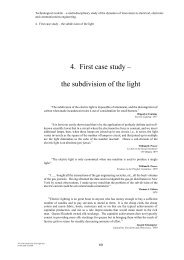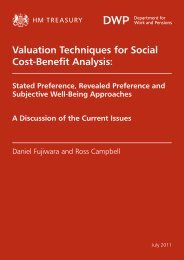Valuing Our Natural Environment Final Report ... - HM Treasury
Valuing Our Natural Environment Final Report ... - HM Treasury
Valuing Our Natural Environment Final Report ... - HM Treasury
You also want an ePaper? Increase the reach of your titles
YUMPU automatically turns print PDFs into web optimized ePapers that Google loves.
<strong>Valuing</strong> <strong>Our</strong> <strong>Natural</strong> <strong>Environment</strong> – <strong>Final</strong> <strong>Report</strong> - Annex1<br />
A1.1.6.10 Key uses – coverage of natural environment<br />
The CVM is particularly flexible and facilitates the valuation of a wide range of<br />
environmental goods and services, including those not currently provided 1 . Practical<br />
examples of application of the CVM are numerous. A bibliography of CVM studies in 1994<br />
(Carson, 1994) revealed almost 2000 separate studies.<br />
A1.1.6.11 Discussion<br />
Much debate has focussed on numerous aspects of the use and reliability of the CVM.<br />
Indeed as Smith (2000) highlights the CVM has brought about the most serious investigation<br />
of individual preferences ever undertaken by economists. Much of the discussion concerning<br />
the CVM, which covers academic, policy and philosophical issues, can perhaps be attributed<br />
to the assessment of the US National Oceanic and Atmospheric Administration (NOAA)<br />
panel, which was commissioned to critically evaluate the validity of the CVM following the<br />
use of the CVM to assess the natural resource damages from the Exxon Valdez oil spill (for<br />
further information see Carson, 1996). The panel endorsed the use of the CVM in<br />
assessment of natural environment damages and set-out extensive guidelines for the<br />
implementation of CVM studies. More recently, a team of UK researchers prepared a<br />
guidance for the then DTLR on the use of stated preference techniques which was<br />
subsequently published as Bateman et al. (2002). The following gives a brief overview of<br />
the main areas of debate concerning the CVM.<br />
A principal criticism of the CVM focuses on the issue of familiarity; specifically that<br />
respondents are required to have experience with the non-market good or service in<br />
question in order for their responses to be meaningful. However, familiarity is typically only<br />
one factor in purchasing decisions of individuals (others being information from reviews,<br />
advertising, etc.) and the question of experience of a good or service extends to market<br />
goods and services as well (see Sugden, 1999). As Carson et al (2001) note, the time spent<br />
familiarising respondents with the good or service that is the focus of the CVM survey<br />
probably exceeds the time that the respondent would spend on purchasing decisions<br />
involving similar amounts of money. The key is for the CVM survey instrument to convey to<br />
respondents an understanding of what they are being asked to value, how it will be<br />
provided and how it will be paid for.<br />
A number of survey design, administration and analysis issues have also been highlighted. In<br />
particular, WTP/WTA estimates are sensitive to the way in which they are elicited and the<br />
key features of the constructed market. For example, different payment vehicles (tax,<br />
voluntary donation, etc.) will typically influence the extent to which individuals are willing<br />
to participate in the market; certain administration formats are likely to give rise to sample<br />
selection bias (e.g. mail surveys), and so on (for a comprehensive account see Bateman et<br />
al., 2002). Debate concerning these issues has generally led to the development of the CVM<br />
and improvements in its application, where high quality ‘state of the art’ studies are less<br />
likely to encounter such issues.<br />
Construction of a hypothetical market for a particular non-market good or service enables<br />
the results of CVM studies to be compared with economic theory. Here there are two key<br />
tests in relation to price and quantity. Firstly, the percentage of respondents willing to pay<br />
a particular price should fall as the price they are asked to pay rises. This effect is typically<br />
observed in all CVM studies. Secondly, respondent should be willing to pay more for larger<br />
amounts of the good or service. This is normally referred to as a test of ‘scope’. Sensitivity<br />
to scope is perhaps one of the most debated aspects of CVM studies (Carson et al., 2001).<br />
While scope insensitivity may be attributed to aspects of the CVM instrument design, some<br />
concern remains in relation to the use of CVM studies in valuing changes in small<br />
probabilities of health risk (see for example Beattie et al., 1998). Here the problem lies<br />
mainly in communicating low level risks to respondents. While price and scope test are<br />
unambiguous (e.g. as price rises, demand should fall; see Hanemann, 1995), conjectures<br />
concerning the relationship between WTP/WTA and income, or divergences between WTP<br />
and WTA measures, or on the effect of order in which a good is valued, are subject to<br />
1 CVM has also been used widely in valuing safety and estimating the value of a statistical life.<br />
eftec A20<br />
December 2006





![AIRTO [Professor Dr Brian Blunden] - HM Treasury](https://img.yumpu.com/15492848/1/184x260/airto-professor-dr-brian-blunden-hm-treasury.jpg?quality=85)










